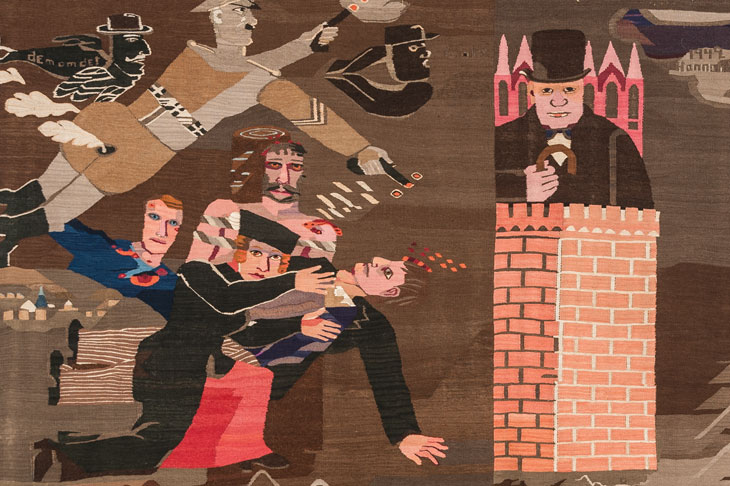During her lifetime, Hannah Ryggen (1894–1970) was widely recognised as one of Scandinavia’s most important artists. Her tapestry The Use of Hands (1949) became in 1953 the first textile work acquired by the National Gallery of Norway, and in 1964 she was selected as the first female artist to represent the country at the Venice Biennale. But today Ryggen is largely unknown beyond Scandinavia; ‘Woven Histories’, the current exhibition at Modern Art Oxford, is the first in-depth exploration of her work in the UK. The exhibition foregrounds Ryggen’s sensitivity to the political tumult of 20th-century Europe. Her monumental tapestries, gritty and unreserved, are a document of both the artist’s own singular life and the socio-political circumstances of her age.
Born in Malmö, Sweden, Ryggen married and moved to Norway in 1924, where she spent most of her artistic career, living and working on a rural farm in Ørland without heat or running water. The artist’s surroundings gave her a direct appreciation of the natural world, reflected in her work. One of the most arresting tapestries on display at Modern Art Oxford, Blood in the Grass (1966), is the only work in which the Ryggen ever used a chemical dye – required to create the vivid ‘blood’ red. Elsewhere, the artist’s subtle, earthy palette calls attention to the natural dyeing processes employed throughout her career. Ryggen used plants, lichens and bark to make her dyes; famously, the luminous ‘pot blue’ that recurs in her work was created using urine which visitors to the farm would deposit.
Jul Kvale (1956), Hannah Ryggen. Photo: Anders S. Solberg/Nordenfjeldske Kunstindustrimuseum. © Hannah Ryggen/DACS 2017. Courtesy Nordenfjeldske Kunstindustrimuseum/Museene I Sør-Trøndelag.
Although Ryggen had trained in painting, she abandoned the medium at a young age, devoting the rest of her career solely to her tapestries. She was self-taught in weaving, which gave her a greater freedom to experiment and develop the unique style traced in ‘Woven Histories’. Equally bold in her imagery, she refrained from sketching plans for her compositions in advance. The resulting crude forms and figures with angular faces set against striking organic and geometric patterns became Ryggen’s signature.
Living remotely, Ryggen’s primary source of information was the left-leaning Norwegian newspaper, Dagbladet. As she wrote in a letter in 1961, ‘Right from my first arrival in Ørlandet, we received Dagbladet – for more than thirty years – and thanks to that we could follow what was going on in the world, which I at least was interested in […]. Even as a child I was a red revolutionary.’
6 October 1942/6. Oktober 1942 (1943), Hannah Ryggen. Photo: Anders S. Solberg/Nordenfjeldske Kunstindustrimuseum. © Hannah Ryggen/DACS 2017. Courtesy Nordenfjeldske Kunstindustrimuseum/Museene I Sør-Trøndelag.
Her art was a direct response to and protest against the rise of fascism in Europe; many tapestries would contain satirical representations of political oppressors, as in 6 October 1942 (1943). In the top left corner of the work, Ryggen depicts Hitler soaring through space, with oak leaves symbolic of the Third Reich springing from his backside. The title refers to the date on which the Nazis, who were occupying the region of Trondheim, imposed martial law in the area. Ten local leaders were executed that day, including theatre director Henry Gleditsch, whose death Ryggen reimagines in her powerful weaving.
Blood in the Grass (1966), Hannah Ryggen. Photo: KODE/Dag Fosse. © Hannah Ryggen/DACS 2017. Courtesy KODE-Art Museums of Bergen.
In Blood in the Grass (1966), a totemic figure dressed as a cowboy, representing then president of the US Lyndon B. Johnson. The man is flanked by a small dog, a reference to a photograph of Johnson lifting one of his beagles by the ears that had recently caused a media frenzy over charges of animal abuse. Ryggen, who was outraged by the lack of coverage of the Vietnam War, here condemns a media distracted by the sensationalist story. This was the final large-scale tapestry she created that made explicit reference to political events. It’s a poignant note on which to end, resonating strongly with the circumstances of our present times.
‘Hannah Ryggen: Woven Histories’ is at Modern Art Oxford until 18 February.
